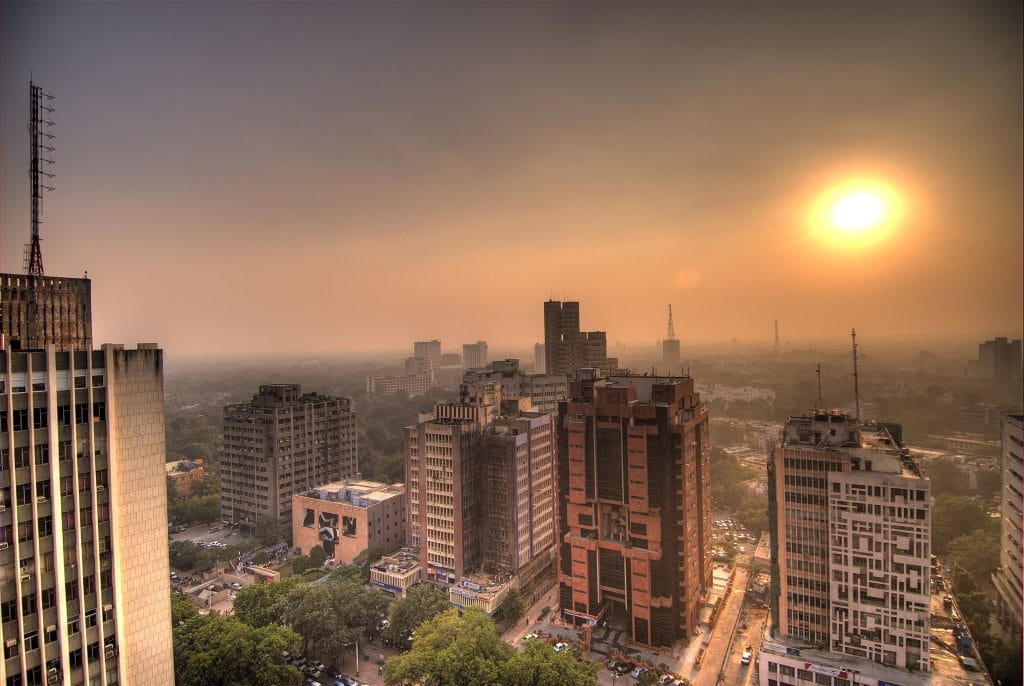
Image credit: By Ville Miettinen from Helsinki, Finland (Connaught Place sunset) [CC BY 2.0 (http://creativecommons.org/licenses/by/2.0)], via Wikimedia Commons
‘Like smoking fifty cigarettes a day’
In some quarters of the city, pollution levels are so poor they exceed the maximum level measured by the air quality index. The volume of PM 2.5 – carcinogenic fine particulate matter – in the atmosphere across the National Capital Region (NCR) hit 728 on November 7. The following afternoon, levels reached 833. The World Health Organization (WHO) says that exposure at levels above 100 is unhealthy. Exposure above 300 is ‘hazardous.’
![New Delhi, India's capital city, is currently suffering though a period of particularly poor air quality. In early November 2016, monitors at various locations in the area posted air quality index measurements as high as the 900s (the most severe ranking, "hazardous," is any air quality index measurement over 300). Thousands of schools have been closed, and a survey by the Associate Chambers of Commerce and Industry of India reports that 10 percent of the city's workers called in sick due to air-pollution-related health issues. According to several published news reports, the extreme air pollution may be due to a combination of nearby agricultural burning after harvest, urban construction and solid-waste burning, as well as remnants of firecracker smoke and additional car emissions after the celebration of Diwali, the Hindu festival of lights, on October 30. The Multi-angle Imaging SpectroRadiometer (MISR) instrument aboard NASA's Terra satellite passed over the region on Saturday, Nov. 5, 2016, at around 11:05 a.m. local time. At left is an image acquired from MISR's vertical viewing camera. The Himalayas stretch across the northern portion of the image. This towering mountain range tends to concentrate pollution in the region immediately to the south, including New Delhi, by preventing pollutants from blowing northwards. New Delhi, whose location is indicated on the image, is under a patch of especially thick haze. At 6:00 a.m. local time on that date, the U.S. Mission India NowCast Air Quality Index for New Delhi was reported at 751, more than twice the threshold for hazardous air quality. At right, a map of aerosol optical depth is superimposed on the image. Optical depth is a quantitative measure of the abundance of aerosols (tiny particles in the atmosphere). Optical depths for the area around New Delhi have not been calculated because the haze is so thick that the algorithm has classified the area as a cloud. In the region immediately surrounding the thick haze, optical depths approach 1.0. An optical depth of 1.0 means that only about 37 percent of direct sunlight reaches the surface due to interactions with particles in the atmosphere. These data were acquired during Terra orbit 89805. Other MISR data are available through the NASA Langley Research Center; for more information, go to https://eosweb.larc.nasa.gov/project/misr/misr_table. MISR was built and is managed by NASA's Jet Propulsion Laboratory, Pasadena, California, for NASA's Science Mission Directorate, Washington, D.C. The Terra spacecraft is managed by NASA's Goddard Space Flight Center, Greenbelt, Maryland. The MISR data were obtained from the NASA Langley Research Center Atmospheric Science Data Center, Hampton, Virginia. JPL is a division of the California Institute of Technology in Pasadena. MISR was built and is managed by NASA's Jet Propulsion Laboratory, Pasadena, California, for NASA's Science Mission Directorate, Washington, D.C. The Terra spacecraft is managed by NASA's Goddard Space Flight Center, Greenbelt, Maryland. The MISR data were obtained from the NASA Langley Research Center Atmospheric Science Data Center, Hampton, Virginia. JPL is a division of Caltech in Pasadena. By NASA/GSFC/LaRC/JPL, MISR Team (Catalog page · Full-res (JPEG · TIFF)) [Public domain], via Wikimedia Commons](/wp-content/uploads/2017/11/PIA21100_-_Severe_Air_Pollution_in_New_Delhi_View_by_NASAs_MISR-300x237.jpg)
By NASA/GSFC/LaRC/JPL, MISR Team
Health problems are already being reported as a result of the pollution. Difficulty breathing, skin and eye irritation, nausea and fatigue are among the most common complaints. This will get much worse.
At current levels, even those in good health will suffer according to India’s Central Pollution Control Board (CPCB). Those with pre-existing conditions will witness even more severe impacts.
Among the most polluted cities in the world
Indian cities are among the most polluted in the world. This is at substantial cost to public health across the country.
A study published last month in The Lancet found India accounts for 2.5 million premature pollution-related deaths yearly – more than any other country. A multiplicity of health effects are linked to air pollution, ranging from cardiac and respiratory illness to premature birth.
Delhi is clearly in the throes of an environmental catastrophe that is expected to get worse. Authorities anticipate air quality will deteriorate further in the coming days. If so public health will, as a matter of certainty, decline with it.

